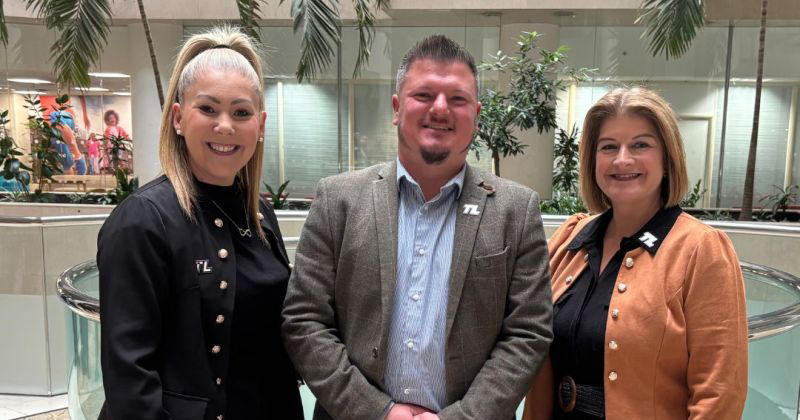With ministers pushing for higher T Level student numbers, Dawn Helsby, the new Midlands chair of the T Level ambassador network, tells FE Week senior reporter Anviksha Patel why creative, well-planned placements – and not targets – will determine the qualification’s future
It’s no secret that the take-up of T Levels since their 2020 launch has disappointed ministers. So one of the people appointed to fly the flag for the qualifications is examining how 1,000 volunteer ambassadors can raise their game.
Dawn Helsby, chosen this week as chair of the Midlands T Level ambassador network, told FE Week her first priority was to “really understand” what’s holding the 200 ambassadors in her patch back.
Getting enough employers to offer mandatory 45-day industry placements is a core responsibility for a T Level ambassador. But as enrolments have grown, so have fears there won’t be enough placements to go around.
Helsby’s strategy is to help employers be “creative” with their workforce planning so T Level placements fit seamlessly as vacancies or gaps arise.
But it’s not only about quantity.
“It isn’t just about numbers, it’s about the quality of placement,” she told FE Week. “Even though we might have industry gaps in the region, you’re going to have different gaps within organisations.”
The Department for Education launched the ambassador scheme in 2021 to promote the “recognition and adoption” of T Levels. Four years on, the volunteer force has topped 1,000.
Helsby, an early careers development officer at Schneider Electric by day, now leads one of three new regional divisions alongside NHS workforce manager Simon Bone (South) and university T Level placement manager Jo Hartley-Metcalfe (North).

From ‘reactive to proactive’
Helsby’s got history with T Levels. She was a student employability manager at North Warwickshire and South Leicestershire College in 2018 when T Levels were being consulted on, and she helped create the ambassador network.
Her experience dealing with employers shows as she described her focus on turning awareness-raising about T Levels into tangible opportunities for students.
She wants her network to be “proactive, rather than reactive” in securing the 45-day industry placements that remain one of the T Level programme’s stumbling blocks.
FE Week revealed earlier this year that the ambassador network nationally missed its goal for employers to make up 65 per cent of its members by 2024 – only one third were employers.
The DfE has also underspent its budget for the network, despite being called out by parliament’s public accounts committee for not doing enough to raise awareness of the qualifications among students, parents and employers.
Helsby wouldn’t be drawn on the numbers, saying only that officials “support us fully”.
But rather than chasing recruitment targets, she plans to concentrate on better mobilising the employers she already has access to.
“We’re looking at certain employers in the network with low numbers of T Level students on placement,” she said. “It’s about getting them to think creatively about where they can use students now to fill future skills gaps.”
She gives the example of a company whose placements were limited to logistics but has looming retirements in finance. “Let’s use a T Level student,” she urged.
Helsby hopes her employer ambassadors will cascade that thinking through their own supply chains, and work with the Gatsby Foundation to expand reach. “That is how more employers will come on board,” she said.
Her own employer appears convinced: Schneider Electric hosted five T Level students last year and expects to quadruple that to 20 this year. “Through the power of the network and all these different supportive arms, I’ve had customers reach out to me just from us doing T Levels,” she said.
Getting the message right
Five years into their rollout, poor awareness and high, but reducing, dropout rates still dog the T Level brand. The public accounts committee warned the government must enter “campaign mode” or risk T Levels becoming a “minority pursuit”.
The National Audit Office recently reported that the number of student starts was running 75 per cent below the government’s original target. Helsby prefers to accentuate the positives.
“I think nearly 60,000 students since 2020 is a phenomenal amount,” she said. “Five years isn’t actually a long time to really grow, nurture and turn things around. If you look at 10 years, then you’re really going to see a massive flourish.
“Whether that might not be necessarily what was forecasted for, I can’t comment on that.”
The network, Helsby added, is turning its attention to “improving the messaging more towards young people”.
DfE data shows T Level awareness among pupils in years 9 to 11 climbed from 8 per cent in 2019 to 50 per cent in 2023.
Helsby recently joined a webinar with thousands of year 10s and 11s and wants more of that: “Twenty-minute sessions explaining ‘this is what a T Level is’. These sorts of things are starting to happen now.”
Parental awareness remains lower still; a new EngineeringUK survey found 42 per cent of parents had never heard of T Levels, or were unsure if they had.
Helsby argues that colleges and employers must do more at parents’ evenings and open days. “This is where colleges are starting to flip how they create that message for parental awareness,” she said.
With the DfE poised to publish its long-awaited post-16 white paper that could recast technical education once again, Helsby’s focus on practical, proactive employer engagement is a reminder that real progress for students will depend on what happens far from Whitehall.
















So she is talking about Industry placements and there is not a single mention of the Support Fund, just that is a great idea to take students on placement?! Over 50% of private sector employment is SME, yet this year they are being treated terribly and expected to loose thousands of pounds on these placements because of how bad the support is, how hard it is to get paid the support, it is very difficult and stressful to try to get the support paid, and in general just how really badly the Targeted Support Fund is being operated. So many bad stories of terrible experiences the SMEs are having. We had a College say last month to us, we prefer to do business with larger companies not an SME, they actually said that to us, and we have had a lot worse.
Properly support the SME sector for T Levels to ever actually succeed.
Do they even understand cash flow for small business? Some payments that were due to be sent to colleges are not here, the business has to go through hurdle after hurdle just to get the support that it was promised when it volunteered to do t level placements. What a truly awful experience they have turned this into.